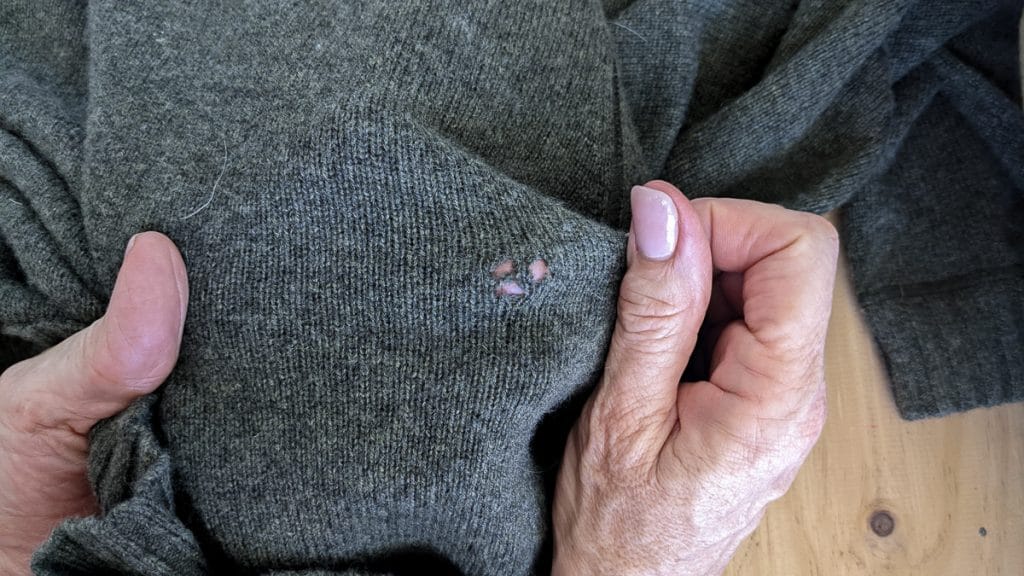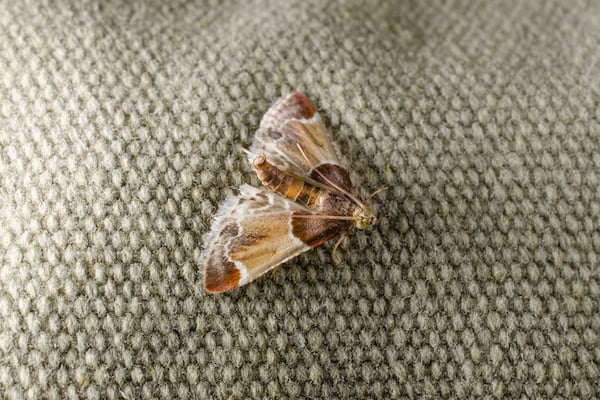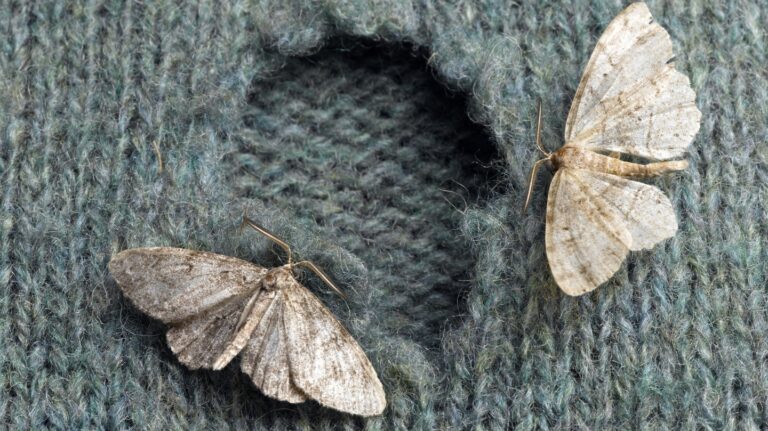Yes, some moths can eat cotton. The most notorious cotton-feeding moth is the cotton bollworm (Helicoverpa zea), also known as the corn earworm. These moths can infest and damage cotton plants by feeding on the cotton bolls, which are the seed capsules of the cotton plant.
However, it’s important to note that adult moths do not eat cotton. Instead, it’s the moth larvae (caterpillars) that feed on cotton. The caterpillars of the cotton bollworm are known for their voracious appetite and can cause significant damage to cotton crops if left unchecked.
How do cotton bollworms affect cotton?
Different moth species may exhibit variations in behavior, life cycles, and susceptibility to control methods, necessitating tailored strategies for each.
Cotton Bollworm (Helicoverpa zea)
The cotton bollworm, also known as the corn earworm, is a moth species with a wingspan ranging from 1 to 1.5 inches (2.5 to 3.8 cm). They typically have a mottled brown or gray appearance, making them well-camouflaged.
One distinctive feature is a pale, diamond-shaped marking on each forewing. Male and female cotton bollworm moths may exhibit slight differences in size and wing markings.
Habitat and Distribution:

Cotton bollworms are highly adaptable and can thrive in a wide range of habitats. They are commonly found in agricultural fields, including cotton, corn, soybeans, and various vegetable crops.
Moreover, these moths are found throughout North and South America and are considered a major agricultural pest in many regions.
Life Cycle:
- Egg Stage: Adult female cotton bollworm moths lay their eggs on the leaves and buds of host plants. The eggs are small, spherical, and initially pale in color.
- Larval Stage (Caterpillar): Upon hatching, the larvae (caterpillars) feed voraciously on the host plant, including cotton bolls, leaves, and flowers. They can vary in color, from green to brown or pink, depending on their diet and age.
- Pupal Stage: After completing their larval development, the caterpillars pupate in the soil. The pupa is enclosed in a protective cocoon.
- Adult Stage: Adult moths emerge from the pupae, and the cycle repeats. The entire life cycle can be completed in as little as 25 to 30 days, depending on environmental conditions.
Other Moth Species That May Infest Cotton:
While the cotton bollworm is one of the most prominent cotton-feeding moths, several other moth species can also infest cotton crops to varying degrees. Some of these include:
Pink Bollworm (Pectinophora gossypiella):
Pink bollworms are relatively small, pinkish-gray moths with distinctive pinkish larvae. In addition, they primarily infest cotton crops and are found in cotton-growing regions worldwide. They have historically been a significant cotton pest.
Tobacco Budworm (Heliothis virescens) and Tobacco Hornworm (Manduca sexta)
These moths are closely related to the cotton bollworm and may also infest cotton crops.
Moreover, they are found in agricultural areas, including cotton fields, and can cause damage similar to that of the cotton bollworm.
Fall Armyworm (Spodoptera frugiperda):
While primarily known as a pest of corn and other crops, the fall armyworm can occasionally infest cotton.
Additionally, they are widespread in the Americas and have been known to affect cotton production during outbreaks.
What do moth larvae eat in cotton?
A detailed understanding of the life stages and feeding behavior of cotton-feeding moths is critical for implementing effective pest control measures and mitigating the damage they can cause to cotton crops.
Egg Stage
Female moths lay their eggs on or near suitable host plants, including cotton. They typically select locations that provide protection and access to food for the emerging larvae.
Moth eggs are usually small and spherical, often pale in color, and may be laid individually or in clusters, depending on the species.
Larval Stage (Caterpillar)
- Hatching and Feeding: Upon hatching from the eggs, moth larvae, also known as caterpillars, enter the larval stage. This is the stage where they actively feed and grow.
- Feeding Behavior: Caterpillars are herbivorous and primarily feed on plant material. The specific plant parts they consume can vary among moth species but often
include leaves, flowers, seeds, and in the case of cotton-feeding moths, cotton bolls.
- Mouthparts: Caterpillars have specialized mouthparts, including mandibles, which allow them to cut and chew plant tissue.
Pupal Stage:
After a period of feeding and growth, caterpillars enter the pupal stage. They typically pupate in the soil or in a protective cocoon, depending on the species.
Inside the pupa, the caterpillar undergoes metamorphosis, transforming into an adult moth. This stage is characterized by dramatic changes in body structure and physiology.
Adult Stage:
Adult moths emerge from the pupal stage and are typically characterized by their wings, which allow them to fly and reproduce.
In addition, adult moths primarily focus on reproduction, with males seeking females for mating. After mating, female moths lay eggs to initiate the next generation.
Feeding Habits of Moth Larvae (Caterpillars)
Moth larvae, including those of cotton-feeding moths like the cotton bollworm, have specialized diets and are highly adapted to specific host plants.
In the case of cotton-feeding moths, they primarily consume cotton plant parts, especially cotton bolls.
Some moth species may have broader diets, while others are highly specialized and may only feed on a single type of plant.
How They Feed on Cotton
Cotton-feeding moth larvae are particularly damaging to cotton crops because they feed on the cotton bolls, which contain the valuable cotton fibers and seeds. They may bore into the bolls, damaging the fibers and rendering the seeds unviable.
Caterpillars use their mandibles to chew through the protective layers of the cotton bolls and access the cotton fibers and seeds within.
The feeding activity of caterpillars can result in reduced cotton yield, quality, and economic losses for cotton farmers.
Moth Behavior as It Relates to Cotton Damage
Moth behavior plays a crucial role in cotton damage. Adult moths are attracted to cotton fields for laying their eggs, especially when cotton plants are in a susceptible growth stage. They use chemical cues, such as plant volatiles, to locate suitable host plants.
Female moths select appropriate locations on the cotton plant, such as the bolls, to deposit their eggs. This behavior ensures that the emerging larvae have access to a readily available food source.
The timing of moth infestations is influenced by factors like temperature, photoperiod, and the growth stage of cotton plants. Understanding the behavior of moths in relation to these factors is essential for pest management and control strategies.
How does moth damage impact cotton economically?

The extensive impact of moths on cotton, both economically and historically, underscores the importance of effective pest management practices and ongoing research into sustainable and environmentally friendly methods to control these pests.
Damage Caused by Moth Larvae
Cotton Boll Damage: Moth larvae, especially those of the cotton bollworm, cause significant damage to cotton crops by feeding on cotton bolls. They often bore into the bolls to access the cotton fibers and seeds inside.
The feeding activity of moth larvae results in a reduction in the quality of cotton fibers. Damaged fibers may be shorter, weaker, and discolored, making them less desirable for textile production.
Moth larvae not only consume cotton fibers but also damage cotton seeds. This damage reduces seed viability and can impact cottonseed oil production.
Moth infestations can lead to secondary issues, such as increased susceptibility to diseases and other pests. Boll damage provides entry points for pathogens, further affecting cotton plant health.
Economic and Agricultural Consequences
Moth infestations can lead to reduced cotton crop yields due to boll damage and cotton shedding. Cotton plants may drop damaged bolls prematurely, resulting in yield losses.
The damage inflicted by moth larvae can lower the overall quality of cotton fibers, making them less valuable in the textile market. Lower-quality cotton fetches lower prices for growers.
Farmers must invest in pest management measures to combat moth infestations, including the use of insecticides and monitoring practices. These costs can significantly impact the profitability of cotton farming.
The use of chemical insecticides to control moth populations can have environmental implications, including the risk of pesticide runoff and harm to non-target species.
Persistent moth infestations can make crop rotation and pest management planning more complex for cotton farmers. Crop rotation is a common practice to break pest cycles, but moths can affect multiple crops, making control challenging.
FAQ’s
Is cotton moth-proof?
Cotton is not moth-proof. Moths, especially clothes moths, can damage cotton textiles.
Do clothes moths eat cotton or polyester?
Clothes moths primarily target natural fibers like cotton, wool, and silk, but they can also infest and damage polyester if it contains protein residues.
What material do moths hate?
Moths dislike materials with strong scents, such as cedarwood, lavender, or cedar balls, which can deter them from infesting clothing.
What kills moths?
Moths can be killed using various methods, including freezing infested items, heat treatment, and chemical moth repellents or insecticides.
Are clothes moths killed by washing?
Washing clothes at high temperatures (above 120°F or 49°C) can kill clothes moth larvae and eggs. Dry cleaning is another effective option.
What smell kills moths?
Moths are often repelled by the scents of cedarwood, lavender, eucalyptus, and cloves, among others.
What is a moth’s natural enemy?
Natural enemies of moths include parasitoid wasps, predatory insects, and birds, which can help control moth populations in the wild.
Final Words
In conclusion, moths can indeed eat cotton, and their impact on cotton crops is significant. The caterpillars of moths like the cotton bollworm can cause damage by feeding on cotton bolls, reducing both the quantity and quality of cotton fibers. This damage can lead to economic losses for cotton farmers and has historical importance in the world of agriculture.
To manage and control moth infestations in cotton, various methods are used. These include chemical insecticides, biological control with natural enemies, and integrated pest management (IPM), which combines multiple strategies for more sustainable pest control. Resistant cotton varieties and best practices like crop rotation and sanitation also play crucial roles in preventing moth infestations.

